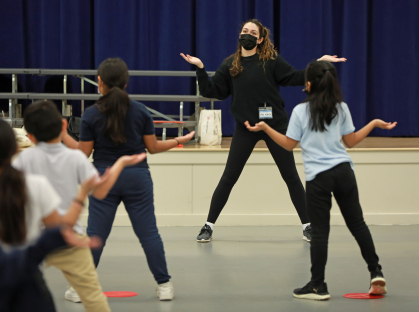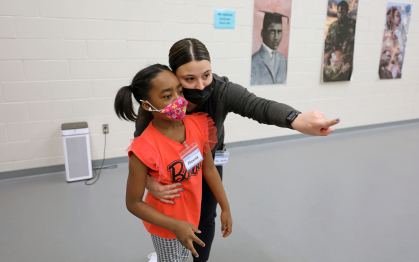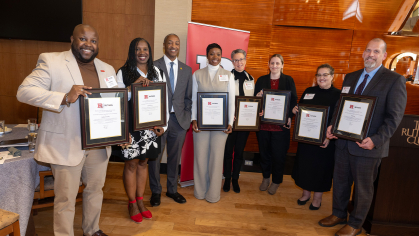Rutgers Students Teach Social Justice Through Dance to Children in New Brunswick
Every Wednesday after school this spring, students at the Paul Robeson Community School for the Arts in New Brunswick have been moving, dancing, leaping and twisting, all while learning about community, emotions and identity.
“Kinetic Connections,” a 10-week program launched in February, teaches social justice through dance to upward of 60 children at the school through a partnership with Rutgers.
Graduate students participating in the five-year teacher education program in dance education (Ed.M.), offered jointly by the Rutgers Graduate School of Education and Mason Gross School of the Arts, complete the "Students, Communities, and Social Justice" course in their final semester while teaching in a local school.

The course allows them to combine the concepts they learn in class with real-world practice in presenting “the big ideas of social justice” to school-age children, says Becky Visintainer, a 2016 dance education alumna who now teaches the course at Rutgers and works as a dance teacher at North Plainfield High School.
“We do a lot of reading about what social justice is in education and some of the current events going on that we could address in classes, but then we ask dance education students, ‘What are your ideas?’” says Visintainer. “How do you integrate this through a dance framework where your students can leave having learned some dance and also learn social justice and be able to apply it in their everyday lives?”
For Cassidy Rivas, who will graduate this May, the answer is enriching the New Brunswick community by helping students feel connected to dance.
Rivas and her co-teacher, Johsian Martinez-Gonzalez, designed their teaching plan to help students understand themselves and those in their neighborhoods. For fourth and fifth graders in their class, this means learning social dances with roots in ’80s and ’90s hip-hop as well as Latin dance styles including bachata, merengue and salsa.
“A lot of the students are of Hispanic descent or African American/Black, so making sure that we get them to see and represent who they are in the classroom was really important to us,” Rivas says. “We always cater to the students and the community and what they may need.”
Participating in the class makes fourth grader Mayki Guardado Mendez feel good.
“My family, they dance bachata, and then they like to push me in, and I don’t want to dance because I don’t know how, and now I know I can dance,” says Guardado Mendez.

“It’s not about right or wrong when it comes to a dance step,” Rivas says. “It’s more about getting to experience that vulnerability in the space, whether it’s a cypher circle in hip-hop, where students get to showcase their individuality, or sharing a dance with a partner, getting to move with people in the same direction.”
Dance classes are divided by grade and provide an age-appropriate curriculum that includes cultural and historical background along with accompanying movement practice—from kindergartners and first graders learning about communities through La Plena, a dance from Puerto Rico, to sixth, seventh and eighth graders learning about identity, diversity, and group dynamics through jazz dance.
“We get to learn dances that we didn’t know about,” says Payton Patilla, a fifth grader who was initially nervous to join the after-school program with so many people she didn’t know aside from her sisters. “I actually feel happy when I dance, because now that we have the program, I can dance in front of people without feeling embarrassed.”
Kara Kamenski is co-teaching the second- and third-grade group with fellow graduate students Jackie Carelli and Kassie Ruboyianes. Their teaching plan promotes social justice and wellness by exploring identity and emotions, including joy, sadness and fear, that students respond to through movement.
“The social-emotional skills students develop help them to recognize their own feelings, empathize with others and build positive relationships,” Kamenski explains.
This is especially important in the wake of the pandemic, Visintainer says.
“It is really hard right now and there’s a lot of learning loss and rebuilding happening,” says Visintainer. “We have to find ways to connect and work together to improve and strengthen a community.”

The program provides Rutgers student-teachers the opportunity to get involved in the New Brunswick community by getting to know the students, their interests and their everyday lives, Kamenski says.
“Our students have been so open to sharing their experiences with us, even when discussing challenging emotions,” Kamenski says. “Our presence fosters a positive relationship between the university and the local community so that we can work together and support each other.”
The after-school program, which ends May 4, has proved so popular that classes have reached capacity.
“There are so many people who want to move and dance. It’s generally enjoyable for them because they’re not sitting down all the time, they can express themselves through movement, they listen to the music they like,” says Jeeseon Chung, the dance teacher at the Paul Robeson School and a 2019 dance education graduate. “That’s what really catches their attention.”
Violet Robinson, principal of the Paul Robeson School, says the program has “ignited the spark to dance in our students.”
“The program inspired self-confidence in both novice and advanced dancers and the encouragement for students to explore the art form of dance,” Robinson adds.
Bringing in programs like “Kinetic Connections” is extremely important, says Sara Martino, the elementary school’s arts integration specialist and a 2018 dance education graduate, because many students, including those with special needs who are bilingual, English-language learners, don’t get to experience the arts outside of school, so movement is a natural way to communicate social issues or topics about culture and history.
“I really appreciate that it has a background of social justice and civic duties, especially for our school and our district, because we really try to home in on culturally responsive learning and teaching as well as social-emotional learning,” says Martino. “By focusing on social justice through the lens of dance, it is so complementary to our mission. It really is an authentic alignment.”


